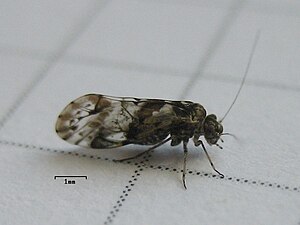Dust lice
| Dust lice | ||||||||||||
|---|---|---|---|---|---|---|---|---|---|---|---|---|

Trichadenotecnum sexpunctatum |
||||||||||||
| Systematics | ||||||||||||
|
||||||||||||
| Scientific name | ||||||||||||
| Psocoptera | ||||||||||||
| Shipley , 1904 |
The dust lice (Psocoptera) are an order of insects , up to 2005 around 5600 species were described worldwide . About 100 species are common in Central Europe. The animals feed on fungal tissue , spores , lichens , green algae or the like. Accordingly, they can be found on plants, under bark , on tree trunks and dead wood , in bird nests or in buildings. Some of the species are able to absorb moisture in the form of water vapor .
features
The dust lice usually reach a size of 0.7 to 10 millimeters, the largest species is Thyrsophorus metallicus . A special feature of these animals are the mouthparts , which represent an intermediate form between the chewing-biting type of ground lice and the sucking type of the other lice, bugs and cicadas . The mandibles of the animals are asymmetrical, the laciniae are bristle- or chisel-shaped and they can be used like a chisel . Many species have spinneret glands that end at the labium .
An autapomorphy of the group is also the construction of the wings . The rear edge of the larger wing is bent like a hook and surrounds the thickened front edge of the rear wing. The females usually only have stub wings or they are completely absent.
Systematics
According to more recent phylogenetic studies, the dust lice (Psocoptera) are placed in the parent group Psocodea . The Psocodea are monophyletic and contain next to the dust lice also the animal lice (Phthiraptera). Together with the Condylognatha, to which the Schnabelkerfe with the plant lice and the bladder feet also belong, the group of the Paraneoptera .
Three sub-orders are distinguished within the dust lice, which can be identified by the number of their antennae and foot limbs ( tarsal limbs ):
Trogiomorpha
The Trogimorpha have long antennae with 22 to 50 limbs, three- limbed tarsi and thickened hind legs. This group includes, for example, the species Psyllipsocus ramburi , which can be found in houses, as well as the death clock ( Trogium pulsatorium ), which is known for its typical knocking in rotten wood . They consist of the following five families:
- Lepidopsocidae
- Trogiidae
- Prionoglarididae
- Psyllipsocidae
- Psoquillidae
Troctomorpha
The antennae of the Troctomorpha have only 15 to 17 members, the tarsi can be two or three members. The book louse Liposcelis simulans or the cave dweller Badonellia titei belong to this group .
Psocomorpha
Most of the native species belong to the group of Psocomorpha or dust lice . With them the antennae always consist of 13 members, the tarsi can be two to three members. This subheading includes the species Psoculus neglectus , which only lives parthenogenetically , the Lachesilla pedicularia , which is often found in bird nests or apartments , the ground dweller Kolbea quisquiliarum and the Valenzuela flavidus , which can be found on deciduous trees . Other species are Loensia variegata and Metylophorus nebulosus . The most species-rich families of the suborder are the Caeciliusidae , Pseudocaeciliidae , Ectopsocidae , Lachesillidae and Psocidae .
Fossil evidence
The oldest fossil representative clearly belonging to the order Psocoptera comes from the Jurassic . (A fossil from the Lower Permian described as a dust louse could, according to other authors, be a fringed winged wing .) All three suborders with representatives from several families are known from Baltic amber . In amber from other Tertiary and Cretaceous deposits, dust lice were found in a wide variety of forms. Some fossil species are very similar to their recent relatives, which today mostly inhabit the tropics and subtropics.
Types (selection)
Individual evidence
- ↑ Alfonso N. García Aldrete (2006): New genera of Psocoptera (Insecta), from Mexico, Belize and Ecuador (Psoquillidae, Ptiloneuridae, Lachesillidae). Zootaxa 1319: pp. 1–14, doi: 10.5281 / zenodo.273553 ( full text as PDF ).
- ↑ David Grimaldi, Michael S. Engel: Evolution of the Insects. Cambridge University Press, New York 2005, p. 147 u. P. 261, ISBN 0-521-82149-5 .
- ↑ C. Gröhn: Inclusions in Baltic amber. Kiel / Hamburg 2015. ISBN 9783529054570 .
- ↑ George O. Poinar, Jr .: Life in Amber . 350 pp., 147 figs., 10 plates, Stanford University Press, Stanford (Cal.) 1992. ISBN 0-8047-2001-0 .
- ↑ Wolfgang Weitschat and Wilfried Wichard: Atlas of plants and animals in Baltic amber , 256 p., Numerous. Fig., Pfeil-Verlag, Munich 1998. ISBN 3-931516-45-8 .
- ↑ Adolf Bachofen-Echt: The amber and its inclusions , 204 p., 188 fig., Springer-Verlag, Vienna 1949.
literature
- David Grimaldi, Michael S. Engel: Evolution of the Insects. Cambridge University Press, New York 2005, ISBN 0-521-82149-5 .
Web links
- National Barkfly Recording Scheme (Britain and Ireland) with photo gallery


